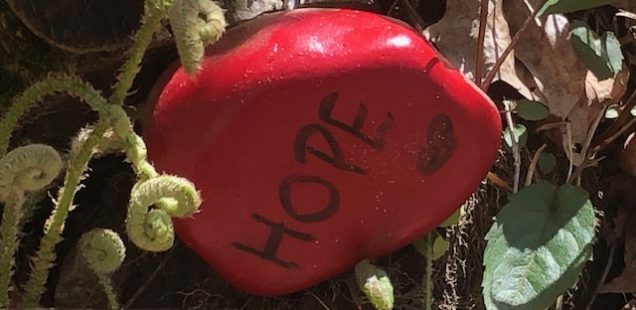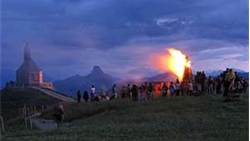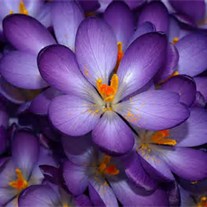
The Stones of Summer
The painted stones began to appear in late April along the unpaved road that ran past the house that had once been a cabinetmaker’s shop. The road skirted the pond that fed the waterfall that in the 1800’s had provided the power to make cabinets and then, closed to through traffic, meandered along a stream and through a small valley and eventually came out onto a road where I had to walk on pavement again and vehicles, SUV’s and pickups mostly, would zoom past.
I had begun walking in mid-March when the schools closed. I did a fifty-minute circuit every day, a power walk that I viewed as a “dose” of exercise and nature, good for me, like taking a multivitamin or drinking a glass of water. I would fill my lungs with the peace of the woods, the birdsong, the quiet gurgle of moving water, the native flowers as they bloomed and faded, but I have to admit, I didn’t stop to look at anything very closely. I had a pace to keep up and I strode on.
The painted stones surprised and then charmed me. They slowed me down. Some were painted in solid colors: currant red, the ice-cream pink you see on houses in the Eastern Caribbean, an azure blue the color of the glazed bricks on Babylon’s ancient Ishtar Gate. Others were representational. There were human and animal faces, hearts, flowers, butterflies, cats, suns and clouds. There were abstract and cubist designs. There were upbeat sayings: “Here Comes the Sun,” “Good Vibes are Contagious” and “Stay Gold.” A few stones had the acronyms of local hospitals emblazoned on them. Some looked as if the painter had written in hieroglyphs, others reminded me of the patterns on Navajo rugs.
I stopped. I bent down to peer. I laughed. Caught up in my own worries about distance learning and without any children of my own, I thought the painted stones were a purely local event. I thought the mothers of my next-door neighbor’s kids, two sisters who had set up housekeeping together, had thought it up. I assumed this because cans of paint sat in front of their fence, a fence that was also painted. Also, one of their children was home-schooled and they always seemed to be thinking up little woodland projects.
I loved the stones. They gave me a different way to walk in the woods, off-schedule, slowly, searching for wonder. I actually began to walk the dirt road twice a day, once, briskly, for exercise and a second time, at a snail’s pace, with my camera.
Every few days the stones would change. New ones would appear, old ones would be moved to a different spot, or vanish altogether. I never saw a child change a stone. They must come out at dusk, I thought, like wood sprites, or later, with the fireflies. I loved the way that walking in one direction I would see some stones and on the return trip, a new perspective would make others visible. I started to look at places where the children hadn’t put a stone: under the dip of a fern, at the edge of a brook, in the rotting depression of a fallen tree, and waiting to see if one day soon they too would see the possibilities of these locations.
“What is the reason for it?” my husband asked.
“It’s art,” I explained, “communication, a living, moving installation.”
And a good way to occupy kids stuck at home for months on end.
By June, I had purchased a set of outdoor acrylic paints for myself and was painting my own stones to put out in our garden.
“It’s all over when you start doing crafts,” I would mutter to myself as I painted on with pleasure. I painted vines and flowers. I did solids and polka dots, matching the colors of the stones to the perennials and annuals of our garden. My favorite pattern of stone decoration was an homage to an earthwork project by Robert Smithson who in 1970 built, from basalt rock, salt crystals, earth and water, a great counterclockwise coil in the Great Salt Lake in Utah. I had always loved the idea of this spiral jetty, the quiet re-arrangement of natural materials that rose from the landscape, that wasn’t inflicted upon it.
In early May, I put a thank-you note in my neighbor’s mailbox. I told the children that the stones were marvelous. I told them not to stop painting. A week or so later, I received a letter from the eight-year-old boy, written in plump, determined cursive, thanking me for my thank you, politely telling me they had not painted all the stones. Others had painted stones, too. His mother had told him I was a teacher. What did I teach? His favorite subjects were math, history and grammar.
I responded of course. I told him I had majored in history. I told him I loved to read. In June, another letter arrived. The boy and his younger cousin had made me hand-painted book marks to set between my pages. The cousin’s mother had scribed a note from her young daughter who was just learning to write. I responded with a letter for each child, jam and fresh berries.
And so the summer marched on, punctuated by letters and stones. The children stopped painting, moved on to other projects. Now it is I who put painted stones out at the end of our drive along the cut-through the neighbor’s children use to get to their grandparent’s house. They find and then move these stones, slipping them from tufts of grass or the flats of rocks into the notches of trees or lay them atop the old gatepost. I go out to check the mail every day to see what new locations the children have found for my stones, to enjoy our socially-distanced communication in the summer of Covid.
The last letter I received thanked me for the jam and advised me they were going camping in the Adirondacks in a few weeks. What kind of candy did I like? There was a special candy store there. They wanted to get me something.
We are living in a charmed, innocent bubble here, but I am aware, of course, that out in the real world, things are dire. We go back to school in three weeks. No one has any idea how it will be. In-person? Hybrid? Virtual?
If we are in-person, and stay that way, I will take some of the stones out of the garden as the weather cools and transfer them to my classroom. Maybe ranged along the windowsill? Or clustered on different tables?
“Maria, you can sit at the table with the pink stones today. Anthony, you take the one with the red spirals.”
I will give to my students the pleasure of the painted stones.
And sanitize them after they leave.





Loved this, Linda! What a charming, enchanting diversion from all the noise in the real world. I am so happy that you had this experience with the children for both them and you. You can’t make this stuff up. Good luck with the coming school year and please stay safe.
I am not looking forward to the total chaos that it is sure to be. We shall see.
The painted stones are acts of kindness, designed to lift up spirits, and they have worked their magic in your neighborhood by forging new bonds. I love the story and the photo too.
Charming and, as always, beautifully written.
How nice! I love painted stones. How lovely to read about your experience.
Kramar från Marie Old